Continued from the previous entry, where I described our visit to
Southeastern Guide Dogs' campus . . . Getting to meet Don was the very
best part of that trip, of course!
We got to see him rather briefly the afternoon of September 4 --
his three-month birthday --
after driving about seven hours from our home in Georgia to
Southeastern's campus
in Palmetto, Florida, which is south of Tampa:
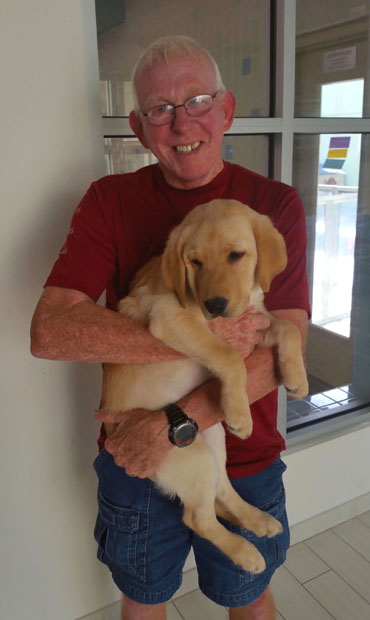
Oh my, that's one big puppy!!
Don was already 26+ pounds when
we got him at 13 weeks of age and more than double
that
at six months.
We also had time that day for Amanda in Puppy Services to show us around
the campus, give us a bunch of papers and items for Don, and talk to us
about our first few days with him.
We thought he'd be more comfortable in the kennel than in our motel room
overnight so we waited until the next morning to pick him up and return
home. We also brought back one of his littermates, a cute black Lab named Frank.
Don and seven other Labs were born to Bayou and Teddy on June 4, 2019 in
the "R19" litter:
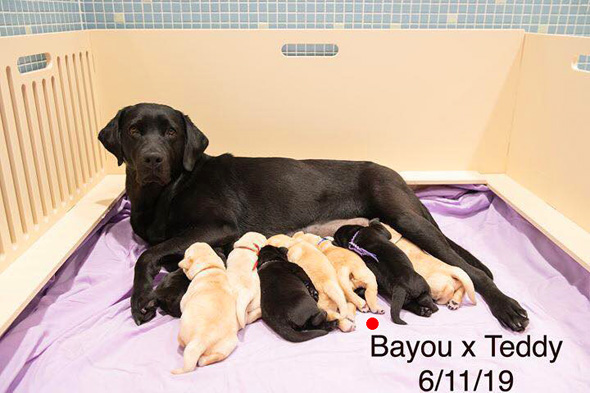
This is Bayou with the R19 litter at one week of
age; I marked Don with a red dot.
Southeastern designates each litter with a letter of the alphabet,
starting with A. They have so many litters that they start over with double letters
like AA when they run out of single letters in any given year. Each guide and service dog
organization has its own unique way of naming litters and individual puppies. Warrior
Canine Connection, e.g., usually gives its litters military-related names.
All the guide and service dog organizations with which I am somewhat
familiar identify their puppies with different collar colors (in
addition to getting microchips).
They wear rick-rack "collars" for about a week, as in the photo above,
then get tiny real collars when they are big enough. The colors are assigned randomly at WCC
but Southeastern uses the same color for each birth order.
Blue is for the fifth puppy to be born in each litter at Southeastern. Don was #5 in
the R19 litter so he was identified for his first 13 weeks with a blue
collar. His ID is 5R19. And no, he doesn't
have to wear a blue collar any more but he often does because it matches
his guide-puppy-in-training coat and it looks so nice with his caramel
fur color (blue and orange are "complimentary" colors on the color
wheel).
Here is Don's six-week photo again -- because he's so darn cute
-- and those of his equally-cute dam and sire at the same
age:
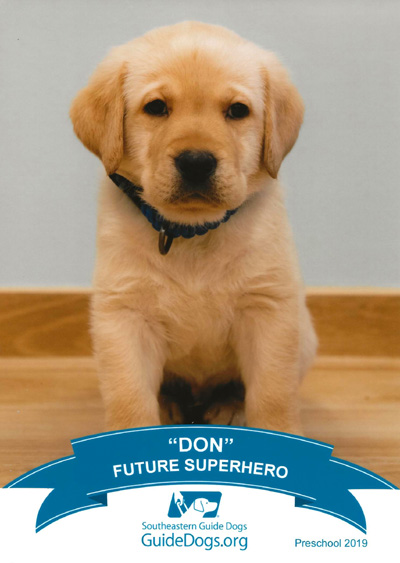
Little Mr. Blue; too bad we didn't see him at that
age.
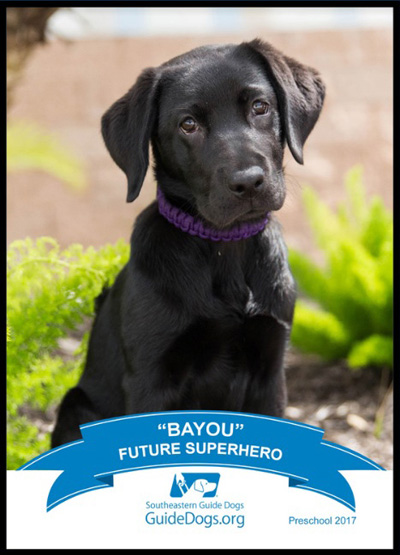
Mama was originally Miss Purple
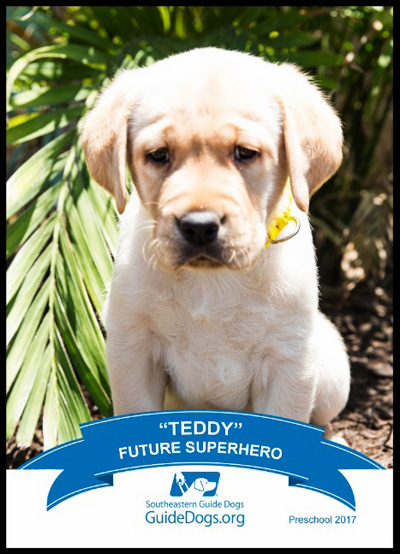
Papa (Don looked a lot like him at the same
age.)
The puppies remain in the whelping area for several weeks before they
are moved to the nursery. At six weeks of age their pictures are taken
and the photos are sent to the puppy raiser, sponsor, and probably the
"furever" person who is matched with the dog after advanced training.
You can see what Bayou looked like as an adult in the litter photo
above.
Below is a photo of Teddy when he was grown -- he looks big
but we don't know his weight. At 16 weeks our vet estimated Don will be 75-80 pounds
at full growth. Since he's already 60 pounds of lean weight at six+
months of age, he will be big like his daddy.
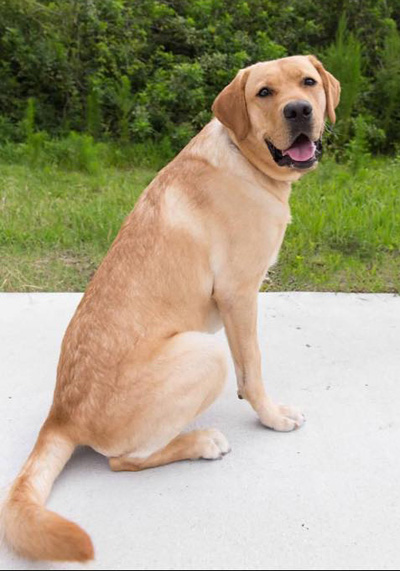
Teddy, Don's sire
We knew we were getting Don for about a week before we traveled down to Florida to
pick him up. We could have gotten him in late August at 12 weeks of age.
However, we delayed our trip so Jim could walk
A Race for the Ages in
Tennessee on Labor Day weekend and have a day of recovery. He
trained for that event all year and didn't want to miss it.
We didn't know Don's name until the day we met him. All the pups
have sponsors who pay $5,000 for the honor of naming them. It's a clever way to
fund-raise! I don't know if the sponsors can choose which puppy bears
their choice of name or not. I'm pretty sure some do, and some sponsors
raise the pup they've named.
This is the only information we've received about Don's sponsor:
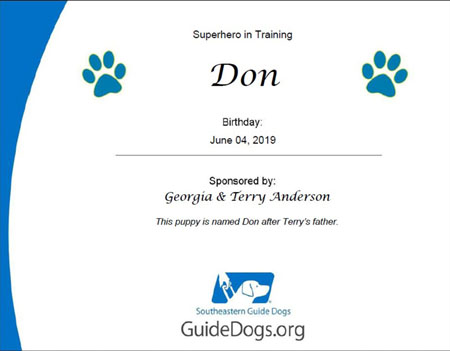
We told Puppy Services that it's fine if the Andersons want to know our names and/or
website and Facebook addresses so they can see pictures I post about Don, but I
don't know if they have been following his progress online.
BOY OR GIRL?
As new raisers for SEGD we were given a choice of only the sex of the
puppy, not its breed or color.
Since our two Lab girls are spayed, we could choose either a male or female puppy.
We had no strong opinion one way or the other. In order to weigh the pros and cons, we did
some internet research and asked friends and Holly's puppy trainer for their
opinions.
We finally decided on a male, since we learned that sometimes three
females in a pack may not get along as well as two females and a male.
And we knew our girls had gotten along well with Cody before he died.
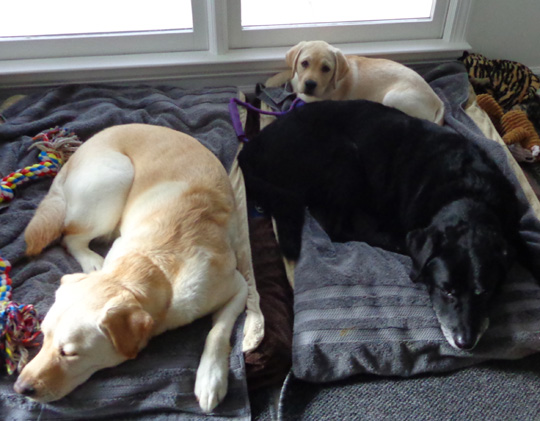
Our only previous canine threesome included Casey
(L), Cody (male black Lab who died at
almost 16 years old in 2018), and Holly,
just 3 months old in this photo from 9-3-17.
I kinda, sorta hoped for a Golden retriever or a goldador, since we
haven't had either of those breeds.
If we got a Lab I had my fingers crossed for a black male, mostly for
some visual contrast between him and our two yellow girls. Now that Don
is as big as Holly and Casey, we often have to look closely to tell who's who!
Alas, it was not to be. We were told our pup would be a yellow male Lab. Not to
worry. We fell in love with him as soon as they sent us his picture. I
mean, look at that sweet, vulnerable face:
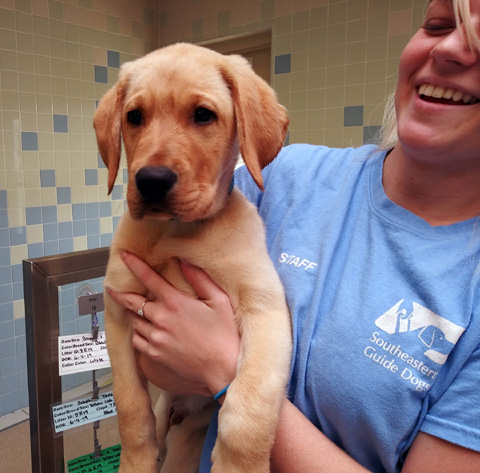
Our biggest surprise when we were notified about the puppy selected for
us to raise was his age -- already three months old.
Warrior Canine Connection usually gives their puppies to the folks raising them at
eight to ten weeks old. Southeastern's website indicates pups leave campus at about
nine to ten
weeks of age. All our pet Labs have been six to eight weeks old when we got them from
breeders, so we're used to puppies that young. We assumed our new little guy would
be nine or ten weeks old, not 13+ weeks.
Both WCC and SEGD had an abundance of puppies born in the first half of 2019 -- and both have had
difficulty finding enough puppy raisers for them, resulting in more puppies either going to
temporary starter homes for a few days or weeks, or staying on campus longer at each organization.
An update in August from Puppy Services at Southeastern noted that more
females were bred in anticipation of a slowdown in heat cycles later
this year. The same thing happened at WCC.

Don's first full day home, with Lamb Chop and Caterpillar
and lots of other
toys that were new to him. Spoiled? Naw, just
well-loved. (9-6-19)
Don's older age was initially a disappointment to us, mostly because we
missed some of his cute earlier development.
On the other
hand, he was still doggone cute at 13 weeks, he had the opportunity for
more training and other experiences on campus before we got him, he was
a little more mature than if he'd been younger, and he was big enough to
hold his own against our playful, two-year-old Holly.
So his age worked in our favor.
When we got our tour of the Puppy Academy I took a photo of the dry-erase board that
lists each current litter in the kindergarten area and what educational activities
and enrichment were scheduled for them that day. Don's litter is at the
top:
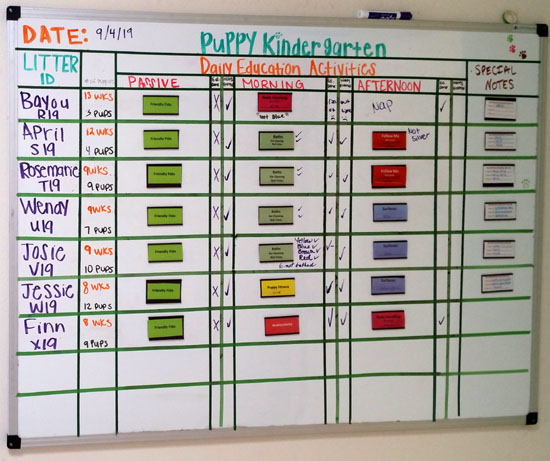
The board shows that a total of fifty-four puppies in seven litters remained in this section
of the Puppy Academy on
September 4, ranging in age from eight to thirteen weeks. More were in
whelping and nursery areas that were younger than eight weeks.
Only Don and two of his seven littermates were still on campus when we
were there. His brothers Frank and Paulson
were in starter homes. The other three puppies were apparently with
their raisers or also in starter homes. [I learned much later that
none of the
pups in this litter were shared with other organizations.]
Frank is with one of the raisers in our Atlanta group so we get to see
him once or twice a month at training sessions. Paulson is being co-raised by two college
students in the Savannah puppy raiser group. We'll get to meet him in
February at the puppy raiser conference in Savannah.
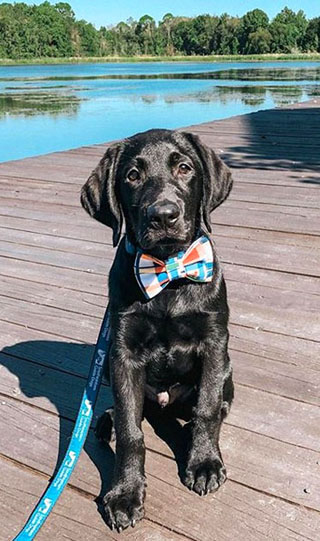
Handsome Paulson at 3 months; photo by Micah Rice
(9-14-19)
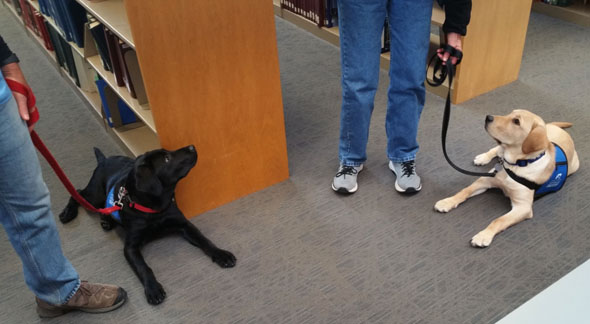
Frank (L) and Don are practicing a long down and paying
attention to handlers instead of each other in
the library on Kennesaw State University campus.
They were 5 months old in this photo. (11-9-19)
It concerned me a little that maybe Don was missing out on some training or socialization by
not being in a starter home but he may have actually gotten more of that in the Puppy Academy.
Enrichment and other activities like body handling are tailored to each puppy, similar to
the way I saw it done at Warrior Canine Connection.
Don quickly adjusted to our home environment even though he hadn't lived in a house yet
or been around older dogs much, if at all.
THE RIDE HOME
Both Don and Frank did very well on the eight-hour drive home on Thursday. It took about
an hour longer on the return trip because we stopped more often with two young puppies
on board to let them walk around, play, eat/drink, and "go busy."
We kept Don on a tie-down on the front passenger floor, as required by SEGD. Jim took these
pictures of him during one of the shifts while I was driving:
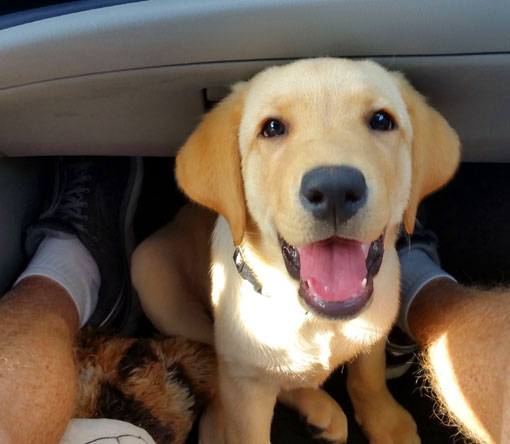
Ready for a new adventure . .
. and the little guy learned his name on the drive home, too.
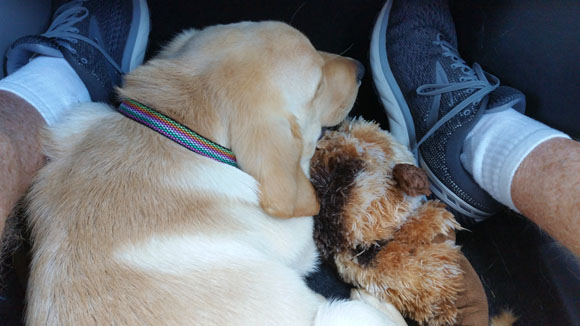
Don slept 90% of the time it took to get home.
We kept Frank right behind us in a crate so we could watch him and talk to him, too.
Frank was already used to riding in a car. Even though Don had
probably never been in a car before, both puppies did great on the
long drive home. They were lulled to sleep almost immediately each time we started
driving again after stops. Neither one whined even once.
Don continues to love riding in our car or truck. By five months of age he was too big to
ride in front if one of us was in the passenger seat. He quickly adjusted to riding with a
short tie-down on the floor behind our seats. If no one is in the front passenger
seat he can still ride on the floor there but not for much longer.
He's about 60 pounds now, with loooong legs.
THE FIRST FEW DAYS HOME
I'm happy to report that Don adjusted to us, our house, yard, dogs, and routines almost
as fast as he adjusted to riding in a car. Jim and I probably had more problems tweaking our
routines to accommodate a new puppy than vice versa!
His first full day with us was busy with lots of new things and he took
it all in with gusto.
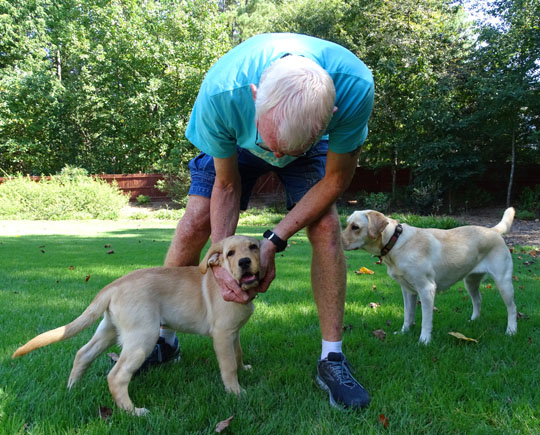
Bonding with Puppy Dad in the back yard after
playing with Holly (9-6-19)
With all the playing and exploring our house and yard,
Don slept well during several naps that day:
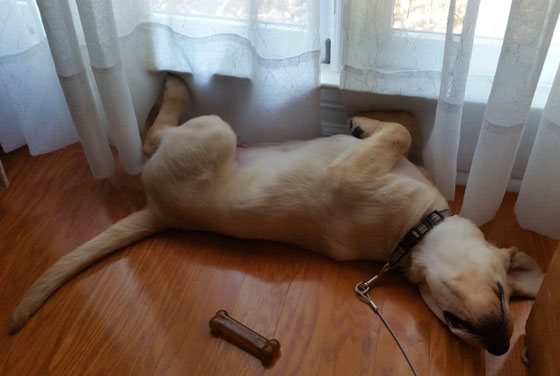
Nice cool floor under the ceiling-mounted AC vent
next to my desk . . . ahhh!
Don loves sleeping on his back, any time, anywhere.
(9-6-19)
Many puppies have difficulty adjusting to suddenly being alone
their first night home and their owners don't get much sleep. Not Don.
Right off the bat he showed us how marvelous guide and service dog
organizations' purpose-breeding and crate training can be. He did great from the very
first night in an unfamiliar crate in an unfamiliar bedroom, suddenly without
his littermates and other litters close by. He didn't
whine or cry, and he didn't even need to go out to pee during the first night.
Wow, that was a first for us with a new puppy! It may also have
been because he was older than any of the puppies we've adopted.
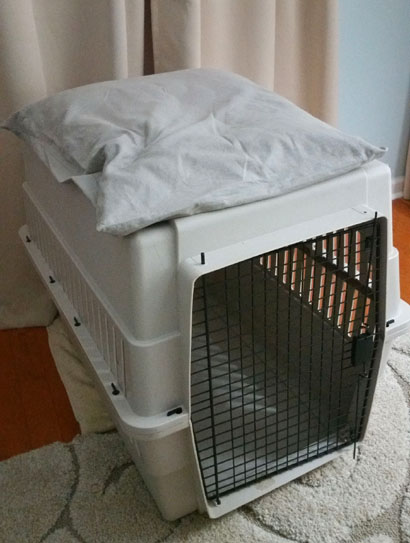
Don still sleeps overnight in this
32" deep fiberglass crate in our bedroom.
When he's a little older he can sleep next to us in a dog bed
on a
tie-down.
We practice that during the day if I take a nap.
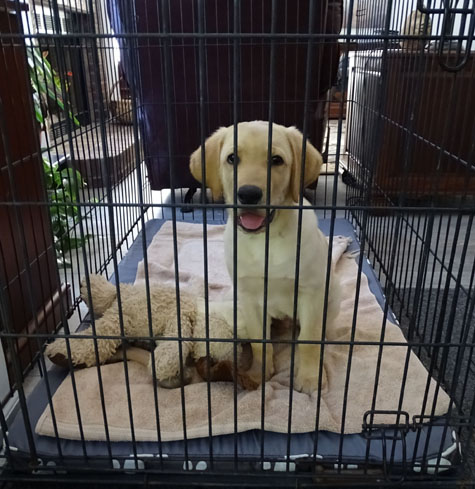
We also have a really large crate
positioned between the kitchen and family room. Don
stays here sometimes during the day and whenever we
are both gone from home. I took
this picture of him after we arrived
home the first afternoon. What a cutie! (9-5-19)
Other signs of excellent early training in the Puppy Academy:
Don didn't jump up on us, didn't bite or mouth us, knew to wait to be
fed and to come out of a crate, came when called, and followed me around
like I'm the Pied Piper.
Those are all very good traits for a guide-puppy-in-training. He has had
some problems with house training, however, and that might have been
easier for us if he'd been in a starter home before we got him.
SURPRISE, GIRLS, YOU'VE GOT A NEW LITTLE BROTHER!
The introduction to Holly and Casey went very smoothly with one dog at a time in
our back yard.
Don quickly learned that seven-year-old Casey will
sometimes play with him, but he needs to be gentle with her.
Two-year-old Holly, still endowed with a puppy brain, showed some initial jealousy
but was Don's BFF within hours. Holly loves having a pup to play with
since Casey doesn't play with her much any more.
I took these (and many more) photos on Don's first few days at our house:
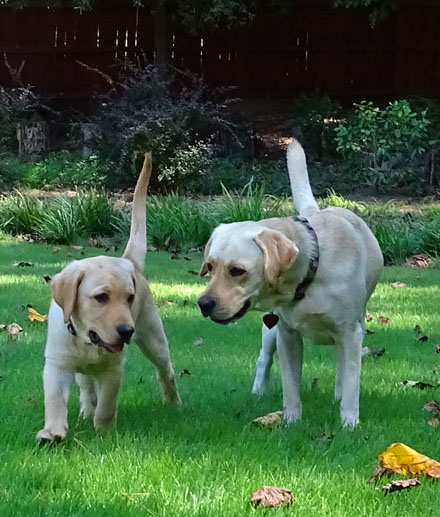
First full day and already best buds!
(9-6-19)

There is no toy-guarding with our three Labs,
even chew bones;
they
all share very well. [Don (L) and Holly, 9-6-19]
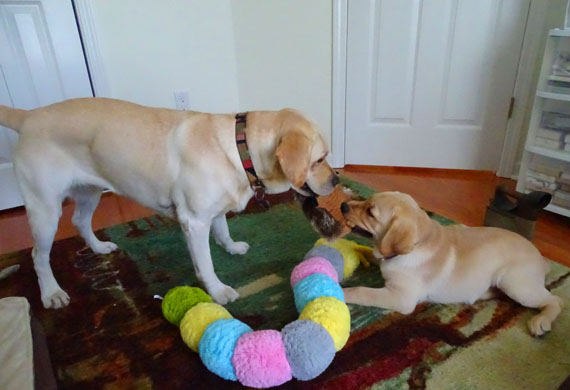
Holly (L) is so cute when she wants to play with
Don or Casey -- she'll literally
stick a toy in their face to encourage them to play
tug with her! (9-6-19)
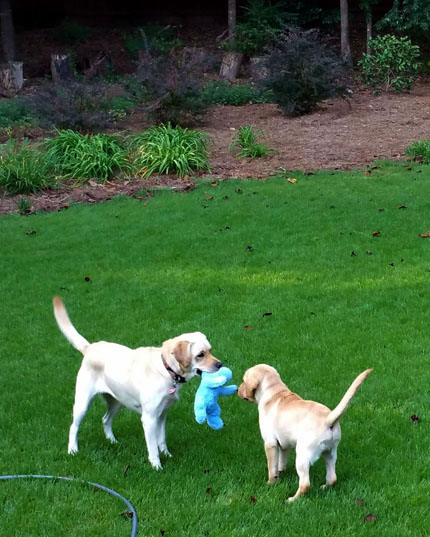
Above and below: Come get it! (9-7-19)
Games of tug soon led to keep-away and
fun chases around the back yard
and through the tunnel. Don held his own just fine!
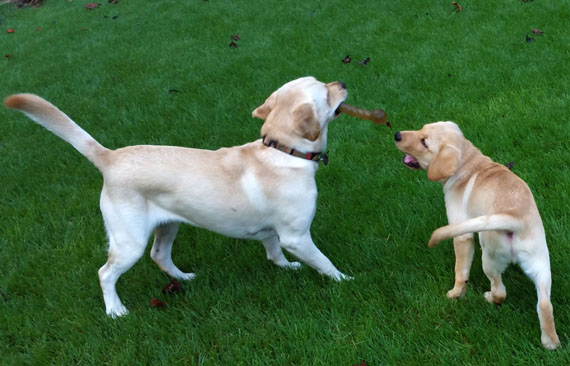
We expected two-year-old Holly to love having a little brother to play with.
She's active, full of life, and loves being with other
dogs.
What came as a pleasant surprise was seven-year-old Casey's new-found
playfulness. She pretty much stopped playing with Holly about a
year ago. As soon as Don came to live with us, however, she
was suddenly running zoomies, tearing through the tunnel, and playing
tug and keep-away again. We love it!
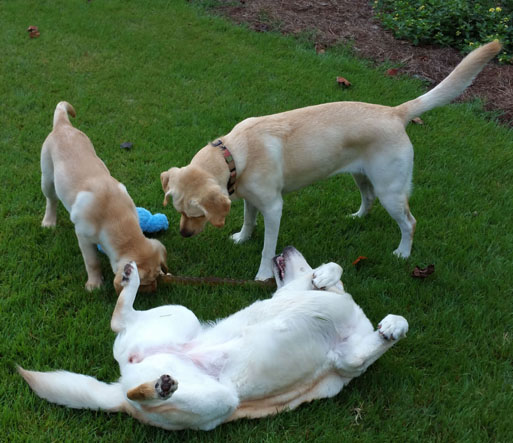
Casey's rolling around in the grass like a
puppy again! (9-6-19)
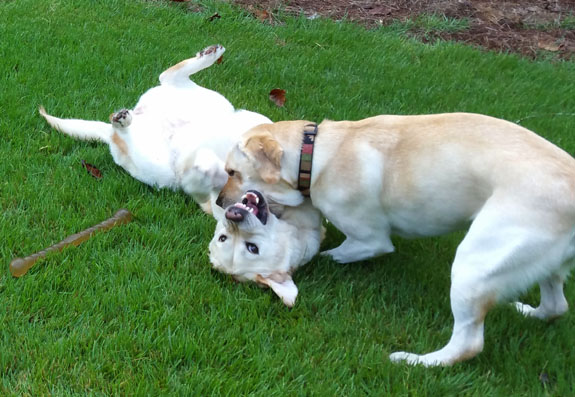
We haven't seen Holly (R) and Casey play like
this in months. (9-7-19)
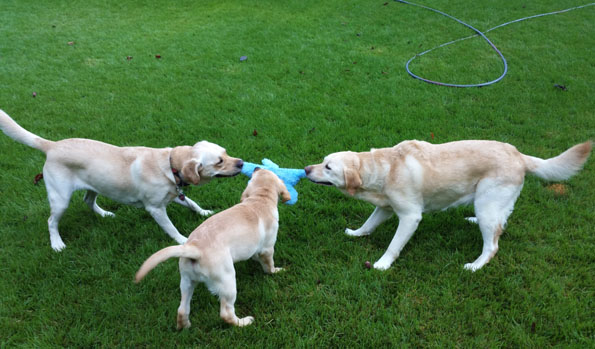
Above and below: A hearty round of
three-way tug with a stuffed toy
(that is still intact today); Holly (L),
Don (center), and Casey (9-7-19)
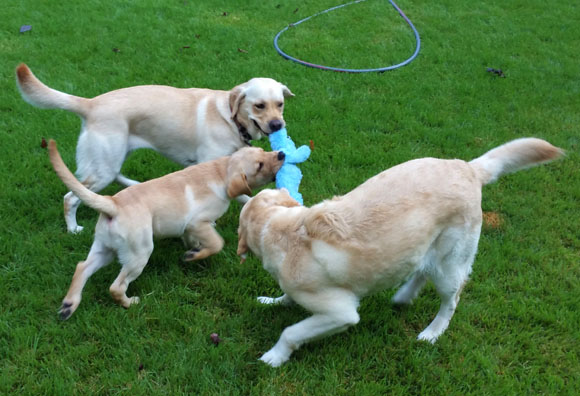

Casey hadn't shown much interest in the
kiddie pool all summer, either, until we got Don.
Holly in foreground, Casey in rear
(9-9-19)
We observed this same phenomenon when we adopted Casey seven
years ago.
Cody, our black Lab, had been our only dog for about four years
and he was already 9+ when Casey
joined his pack. That's getting up there for a Lab (he lived to
almost 16, however). The introduction of a lively eight-week-old
puppy into his life brought out a lot of puppy silliness that
was still left in Cody. That was heart-warming to watch.
Does that work for people, too,
when they get a puppy? I think so! (Although sometimes they give us
more gray hairs.)
Continued in the next entry:
Don's early guide dog training AKA Puppy Kindergarten + more photos
at age three to four months
Happy trails,
Sue
"Runtrails & Company" - Sue Norwood, Jim O'Neil,
Casey-Girl, and Holly-Pup
Previous
Next
© 2019 Sue Norwood and Jim O'Neil